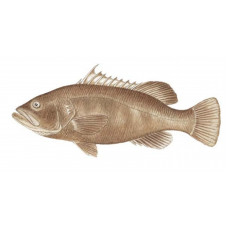Latin name
Epinephelus nigritus
Other names
Spanish: mero de lo alto, mero negro.
Identification
The Warsaw grouper has a gray-brown to dark red-brown body, sometimes irregularly mottled with several small white spots on the sides and dorsal fin, although these are indistinguishable at death. Young grouper have a yellow tail and a dark saddle on the caudal fin. It is distinctive in that it is the only grouper with 10 dorsal spines, the second of which is much longer than the third. It also has a square tail. Unlike the grouper goliath, the rays of the first dorsal fin of the Warsaw grouper are much higher and the head is much larger.
Distribution
In the western Atlantic, the Warsaw grouper inhabits from Massachusetts to the Gulf of Mexico, as far south as Rio de Janeiro in Brazil, and is rare in Cuba, Haiti, and Trinidad. Otherwise, they are fairly common along both coasts of Florida.
Habitat
Usually found over rough, rocky bottoms, deep rocky ledges, and dropoffs, warsaw grouper prefer depths of 300 to 1,000 feet. Young warsaw grouper are occasionally seen or caught near jetties and shallow-water reefs.
Size
The average weight of a Warsaw grouper is about 20 pounds, although 100-pound fish are not uncommon. It can reach a length of 61⁄2 feet and weigh up to 580 pounds. The world record for all gears is a Florida fish weighing 436 pounds 12 ounces. This grouper grows slowly and can live up to 25-30 years.
Life history and Behavior
The eggs and larvae of the Warsaw grouper are believed to be pelagic, about behavior little is known.
Food and feeding habits
Warsaw grouper feed on crabs, shrimp, lobsters, and fish, swallowing prey whole after ambushing it or after a short chase.
Reproduction
Little is known about spawning.
| Classification | |
| Phylum | Chordata |
| Class | Actinopterygii |
| Squad | Perciformes |
| Family | Serranidae |
| Genus | Epinephelus |
| Species | E. nigritus |
| Features | |
| Conservation status | Near Threatened |
| Habitat | Pelagic |
| Life span, years | 50 |
| Maximum body weight, kg | 400 |
| Maximum length, cm | 200 |
| Sailing speed, m/s | No information |
| Threat to people | Edible |
| Way of eating | Predator |



